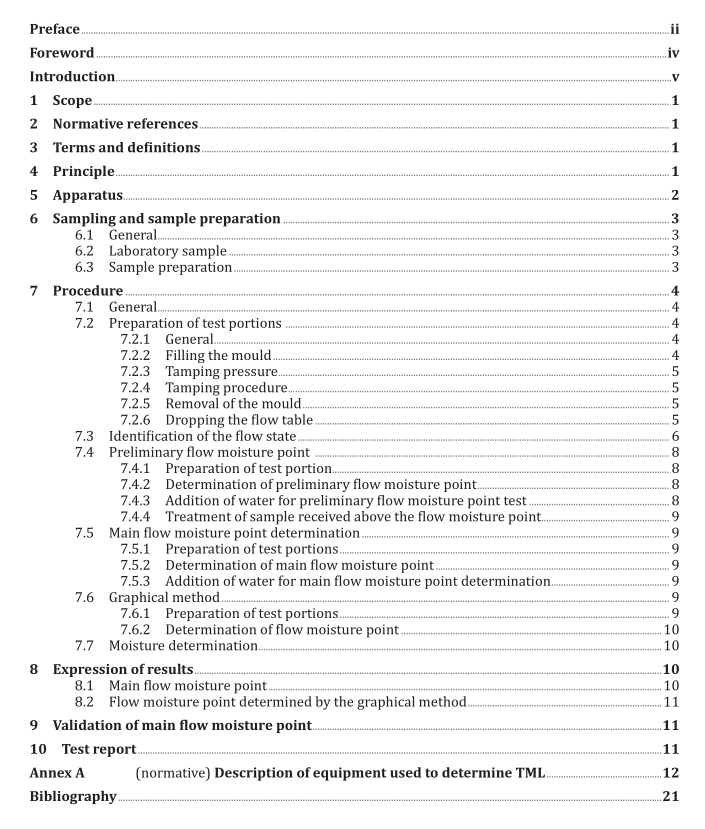AS ISO 12742 pdf download – Copper, lead and zinc sulfide concentrates — Determination of transportable moisture limits — Flow-table method

AS ISO 12742 pdf download – Copper, lead and zinc sulfide concentrates — Determination of transportable moisture limits — Flow-table method
1 Scope
This document specifies a flow-table method for the determination of the transportable moisture limit(TML) of copper, lead and zinc sulfide concentrates, which can liquefy during transport.
lt is applicable to the determination of theTML of concentrates containing 10 % to 80 %(mass fraction)oflead, 10 % to 65 %(mass fraction) of zinc or 10 % to 55 %(mass fraction) of copper and is applicableto TML values in the range 3 % to 28% (mass fraction).
2Normative references
The following documents are referred to in the text in such a way that some or all of their contentconstitutes requirements of this document. For dated references, only the edition cited applies.Forundated references, the latest edition of the referenced document (including any amendments) applies.ISo 10251,Copper, lead,zinc and nickel concentrates—Determination of mass loss of bulk material on dryingISO 12743,Copper, lead, zinc and nickel concentrates —Sampling procedures for determination of metaland moisture content
3Terms and definitions
For the purposes of this document, the following terms and definitions apply.
ISO and IEC maintain terminological databases for use in standardization at the following addresses:-ISO Online browsing platform: available at https://www.org/obp
—IEC Electropedia: available at http://www.electropedia.org/
3.1
flow moisture point
percentage of moisture at which a flow state is reached3.2
transportable moisture limit
maximum percentage of moisture that a cargo can contain during transport without the risk ofliquefaction
4Principle
The moisture content of the sample is adjusted by mixing with water.The mixture is converted toa conical shape using a mould and tamper.The sample is placed on the flow table and the mould isremoved. The flow characteristics are determined by repeated dropping of the flow table whileobserving the behaviour of the sample. When sufficient water has been added to the sample so thatplastic deformation occurs during the dropping of the flow table, the sample is considered to be at itsflow moisture point.
The TML is calculated as 90 % of the flow moisture point.
5Apparatus
Copper, lead and zinc concentrates can gain or lose moisture rapidly when exposed to air.The laboratoryshould be designed so that excessive temperatures, direct sunlight, air currents and humidity variationsare avoided.
5.1 Flow table and frame1), as specified in Annex A.The flow-table mounting shall be as specified in Figure A.1.5.2Mould1), as specified in Figure A.1.
5.3Tamper1).
The required tamping pressure can be achieved by using calibrated, spring-loaded tampers or someother suitable design of tamper that allows a controlled pressure to be applied via a 30 mm diametertamper head as specified in Figure A.2.
5.4Calliper ruler.
5.5 Balance, top loading, having the sensitivity specified in Table 1.
5.6 Measuring cylinder, of capacity 50 ml to 200 ml.
5.7 Burette, of capacity 10 ml.
5.8 Mixing bowl 2) , hemispherical, of diameter approximately 30 cm.
It is recommended that an automatic mechanical mixer having a mixing bowl as described is used, as this leads to improved precision.
5.9 Rubber gloves.
5.10 Drying trays or pans, having dimensions that permit the sample to be spread to a thickness ofless than 30 mm.
The trays shall be made of corrosion-resistant and heat-resistant material, such as stainless steel, glassor enamel plate.
5.11 Drying oven, ventilated, with forced circulation of air or inert gas, regulated at a temperature of105 °C±5 °C.
5.12 Airtight containers.
6 Sampling and sample preparation6.1General
TML figures are required to be updated on a periodic basis,usually six-monthly, or when there is aknown change to the process used to produce the material. The reported figure should be the mean ofsamples taken during the period.
To ensure that the TML result is representative, increments of the material shall be taken in accordancewith ISO 12743, either:
a) while a stockpile is being built up or broken down; orb) while loading or discharging a vessel.
These increments are combined to form the sample used to determine TML.
The sample used to determine TML should not be used to determine moisture content.
Stationary sampling of stockpiles should never be used for the determination of TML. This methodof sampling can only be used to provide an indicative moisture value for use during the planning ofshipping schedules.
6.2 Laboratory sample
Samples for the determination of TML shall be taken in accordance with ISO 12743.The laboratorysample shall not weigh less than 12 kg. To minimize changes to the flow characteristics of the sample,it shall not be oven-dried or ground during its preparation, although partial drying as described in7.4.4 is allowed.









